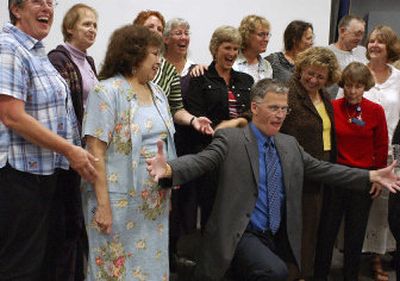As Hospice volunteer, surgeon helped improve quality of death

Dr. Tim Quinn is unusual among surgeons.
Even while saving countless lives at the operating table during the past 23 years, outside the O.R. he’s helped hundreds of people die – with dignity.
Quinn was honored Friday for his 23 years as a volunteer medical director for Hospice of North Idaho. He’s leaving the position to make way for Dr. Robert Ancker, who was recently hired as Kootenai Medical Center’s first palliative care doctor and medical director for Hospice.
Quinn “has given a lot of respect and dignity to our patients,” said Cindy Reed, who heads up Hospice’s clinical services and has been with the nonprofit organization for 19 years.
Quinn has been with Hospice since he was fresh out of medical school. The nurse who started Hospice of North Idaho in 1982 recruited him to be medical director, responsible for patient care, compliance with Medicare rules and communicating with the patient’s primary physician.
When Reed joined the organization four years later, Hospice had a daily census of eight patients, she said. Since then, Hospice has grown to 100 patients on a daily basis and 65 paid employees. Over the course of a year, Hospice of North Idaho now helps about 500 terminally ill patients die in their homes, comfortably and on their own terms, in Kootenai, Shoshone and Benewah counties.
“I didn’t think of it as a long term thing, but it’s been great,” Quinn said. Working with patients who are facing death taught him a lot about patient care, he said.
“There often comes a time when a person has a terminal illness when you stop treating the disease and do what’s best for the patient,” he said. “It was interesting to see things from a non-surgical angle. It helped me to mature as a doctor.”
Sometimes, when a patient didn’t have a primary physician, Quinn would take over that role. And sometimes he made house calls.
“It’s humbling,” he said. “All you have really is holding their hand and you listen to them. And that’s all they want.”
Quinn said palliative care – the practice of making terminally ill patients physically comfortable and preparing them mentally and emotionally for dying – has come a long way since he joined Hospice.
“When we started in the ‘80s, pain management was not as advanced as it is now,” he said. Many doctors were reluctant to prescribe enough narcotics to make a patient comfortable.
Improvements to medication helped prevent overdoses while easing pain, he said. Improved home health equipment, too, has given Hospice nurses better tools for caring for patients at home.
With a palliative care doctor at KMC and working for Hospice, Hospice director Paul Weil said the continuum of care for terminally ill patients can start earlier.
Under Medicare rules, a patient is ineligible for Hospice services until diagnosed as having six or fewer months to live. That’s a tough diagnosis to make, Weil said, and some patients die within weeks of receiving Hospice care.
With a palliative care doctor conferring with doctors of terminally ill patients at KMC, some end-of-life decisions can be made earlier, Weil said.
“Some are so afraid of dying. They have fear of dying in pain, or they have unresolved issues,” he said. Helping them earlier in the process may make a difference in the quality of their death.
Carmen Brochu, KMC’s vice president of patient care, said Quinn was a dedicated advocate for Hospice and for bringing the palliative care program into the hospital.
“What he feels passionate about, he gives his all,” she said.